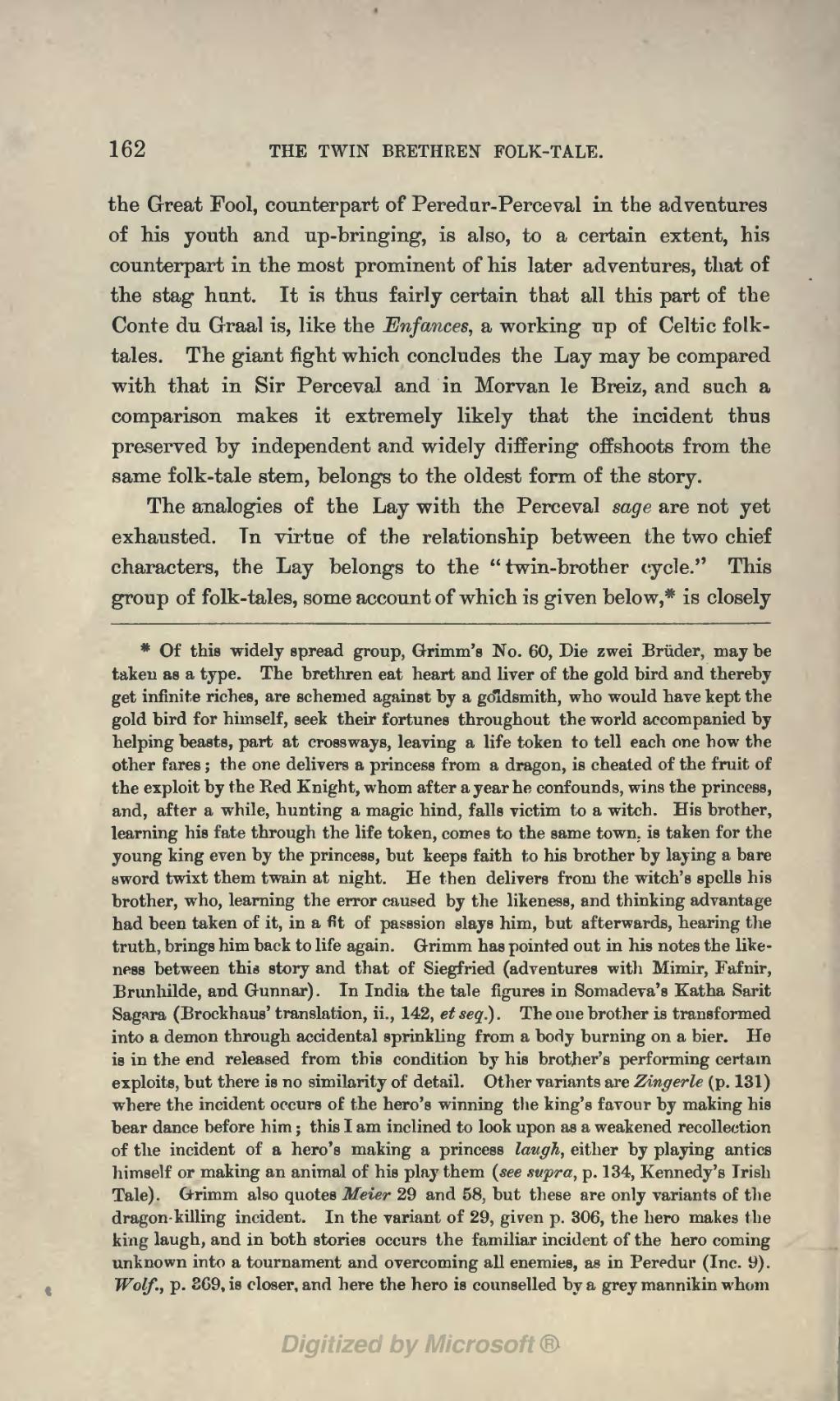the Great Fool, counterpart of Peredur-Perceval in the adventures of his youth and up-bringing, is also, to a certain extent, his counterpart in the most prominent of his later adventures, that of the stag hunt. It is thus fairly certain that all this part of the Conte du Graal is, like the Enfances, a working up of Celtic folk-tales. The giant fight which concludes the Lay may be compared with that in Sir Perceval and in Morvan le Breiz, and such a comparison makes it extremely likely that the incident thus preserved by independent and widely differing offshoots from the same folk-tale stem, belongs to the oldest form of the story.
The analogies of the Lay with the Perceval sage are not yet exhausted. In virtue of the relationship between the two chief characters, the Lay belongs to the "twin-brother cycle." This group of folk-tales, some account of which is given below,[1] is closely
- ↑ Of this widely spread group, Grimm's No. 60, Die zwei Brüder, may be taken as a type. The brethren eat heart and liver of the gold bird and thereby get infinite riches, are schemed against by a goldsmith, who would have kept the gold bird for himself, seek their fortunes throughout the world accompanied by helping beasts, part at crossways, leaving a life token to tell each one how the other fares; the one delivers a princess from a dragon, is cheated of the fruit of the exploit by the Red Knight, whom after a year he confounds, wins the princess, and, after a while, hunting a magic hind, falls victim to a witch. His brother, learning his fate through the life token, comes to the same town, is taken for the young king even by the princess, but keeps faith to his brother by laying a bare sword twixt them twain at night. He then delivers from the witch's spells his brother, who, learning the error caused by the likeness, and thinking advantage had been taken of it, in a fit of passsion slays him, but afterwards, hearing the truth, brings him back to life again. Grimm has pointed out in his notes the likeness between this story and that of Siegfried (adventures with Mimir, Fafnir, Brunhilde, and Gunnar). In India the tale figures in Somadeva's Katha Sarit Sagara (Brockhaus' translation, ii., 142, et seq.). The one brother is transformed into a demon through accidental sprinkling from a body burning on a bier. He is in the end released from this condition by his brother's performing certain exploits, but there is no similarity of detail. Other variants are Zingerle (p. 131) where the incident occurs of the hero's winning the king's favour by making his bear dance before him; this I am inclined to look upon as a weakened recollection of the incident of a hero's making a princess laugh, either by playing antics himself or making an animal of his play them (see supra, p. 134, Kennedy's Irish Tale). Grimm also quotes Meier 29 and 58, but these are only variants of the dragon-killing incident. In the variant of 29, given p. 306, the hero makes the king laugh, and in both stories occurs the familiar incident of the hero coming unknown into a tournament and overcoming all enemies, as in Peredur (Inc. 9). Wolf., p. 369, is closer, and here the hero is counselled by a grey mannikin whom
